ROUNDUP: Nara International Film Festival 2020
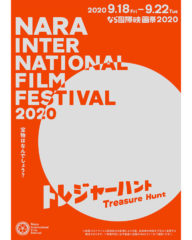
Cinematic Treasures Abound in Japan’s Ancient Capital
Nara Kokusai Eigasai 2020 Roundup
なら国際映画祭 2020 ラウンドアップ
Official website:
nara-iff.jp/2020/
Most of us were unable to attend the Venice, Toronto or San Sebastian film festivals this fall, all three of which marked celebrated “cinema reopening milestones” in their respective countries (Italy, Canada, Spain) after the year’s other big festivals had been canceled or forced completely online due to Covid-19. For those in Japan, the Nara International Film Festival (running September 18 – 22 in the eponymous ancient capital) thus played an even more essential role for cinemaphiles, and its decision to go hybrid, with both physical and online screenings/events, was widely applauded.
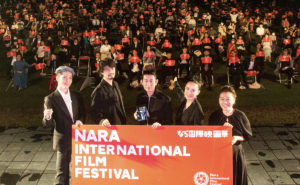
Miyavi, Takumi Saitoh, Masatoshi Nagase, NIFF Executive Director Naomi Kawase
and NIFF Chairperson Satoko Nakano kick of the festival. (Courtesy of NIFF)
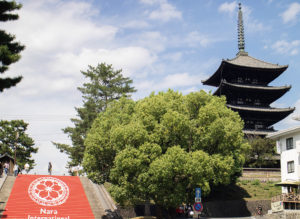
A red carpet and Kofukuji's 5-story pagoda. ©Koichi Mori
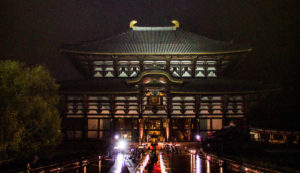
A wet red carpet at Todaiji on opening night. ©Koichi Mori
The biennial NIFF was marking its 6th edition this year, as well as its 10th anniversary since founding, and the celebration incorporated Nara’s stunning UNESCO World Heritage Sites in ways that other film festivals can only dream of. Festivities kicked off at Todaiji Temple, home of the 15-meter-high Great Buddha, housed under the largest wooden structure in the world. Several hundred participants walked the length of the red carpet on opening night, monks chanting as they neared the inner precincts. The Todaiji complex had been constructed on orders from Emperor Shomu to calm a smallpox epidemic during the Nara period (AD 710 – 794), creating pointed parallels with today’s pandemic.
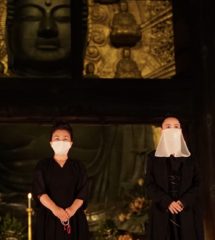
Nakano and Kawase under the Great Buddha. (Courtesy of NIFF)
The red carpet walkers then attended the opening ceremony outdoors at Nara Park’s Kasugano-enchi, as it rained intermittently and deer sat in increasingly drenched clumps nearby, paying no mind to the buzz of activity on stage. (The festival’s commitment to social distancing and sanitizing was evident immediately here, with carefully spaced seating, masked introductions, dedicated microphones and only very brief spurts of interaction during photo calls.)
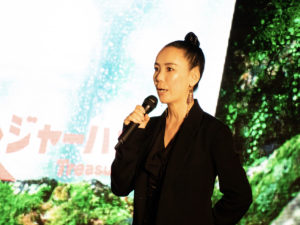
Naomi Kawase ©Koichi Mori
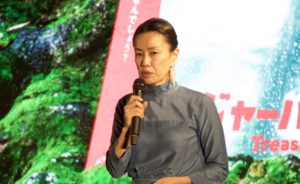
NARA-wave juror Makiko Watanabe ©Koichi Mori
Another of NIFF’s impressive collaborations with local sites were several after-dark NARA’ndez-vous events held in front of Kofukuji Temple’s Chukondo and lit by thousands of candles in the courtyard. At these, the festival’s executive director, globally acclaimed filmmaker Naomi Kawase, hosted celebrity guests like Takumi Saitoh, one of NIFF’s ambassadors (the other, newly named, is Masatoshi Nagase, a regular in Kawase’s films).
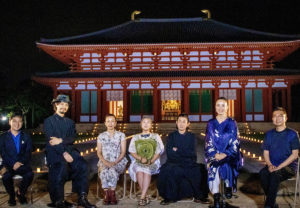
Ryutaro Nakagawa, Takumi Saitoh, Watanabe, International Competition juror Nobuko Nakano, Masatoshi Nagase, Naomi Kawase, Sou Fujimoto at Kofukuji. ©Koichi Mori
The festival also featured a spectacular evening at Kasuga Grand Shrine, along a path ablaze with 3,000 lanterns, wending upward through a primeval cedar and black pine forest. In an inner courtyard, lit only by torchlight, pianist Mine Kawakami evoked the ancient spirit of Nara through a selection of melodies that brought alive the seasonal sounds and sensations of the area’s lush environs — accompanied occasionally by the bleating of deer.
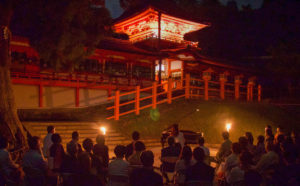
Pianist Mine Kawakami at Kasuga Grand Shrine. ©Koichi Mori
But we digress. The true highlights of the festival, of course, are the films themselves, and despite restricted crowds and Q&A sessions necessarily conducted via Zoom, there were many titles worth noting. These included international selections, but as ever, Tokyo Filmgoer will focus on English-subbed Japanese films.
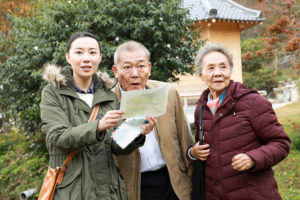
Tracing Her Shadow Courtesy of NIFF
This year’s first highlight was the cross-cultural love story/mystery Tracing Her Shadow, by single-named Chinese director Pengfei. The film was executive produced by Kawase and Chinese auteur Jia Zhangke as part of the festival’s NARAtive filmmaking project, which brings directors to Nara in the years between each NIFF iteration, where they make films with the local communities around the prefecture. It has already been heralded as an antiwar film that shows no scenes of war, but more than that, it is a story of maternal love and national culpability. 
Tracing Her Shadow Courtesy of NIFF
Tracing Her Shadow is about a young Chinese woman, Xiaoze (Ze Ying), who has been based in Japan for many years when a close family friend, Granny Chen (veteran Wu Yanshu) comes to visit and asks her help in locating the Japanese war orphan whom she’d raised as her own daughter. In 1944, Japan had sent some 330,000 farmers to China, calling them “pioneers;” but after the war ended in 1945, most of them fled, leaving 4,000 children behind to be raised by locals like Granny Chen. Following the normalization of relations in 1972, organizations in both countries have been working to reunite these war orphans, but they often have nothing more to go on than fading memories of parents. Some don’t even know their original Japanese names, complicating any hopes of a reunion.
With photographs and letters as their only clues, Xiaoze and Granny Chen take off on what could possibly be a wild goose chase, encountering colorful characters along the way, including two played by Japanese stalwarts Jun Kunimura (a former cop) and Masatoshi Nagase (a deaf gardener). Peifang, who has worked with Taiwanese arthouse hero Tsai Ming Liang, exhibits a deft touch, an eye for telling details, a way with comical moments, and a real compassion for the lonely and the aging (as in a lovely silent scene between Wu and Kunimura, involving photos and reading glasses).
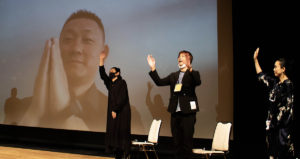
Pengfei (on screen), Nagase, Shintaro Akiyama and Kawase. ©Koichi Mori
During a Q&A session following the screening, Kawase, Nagase, Shintaro Akiyama and the mayor of the small Nara Prefecture town where the film was shot gathered on stage to recall the 2019 shoot, and to laud the director’s skill. Pengfei (on the screen behind them via Zoom) summarized the film’s intentions this way: “The Japanese and the Chinese have a long history together, both good and bad. I hope the relationship will become friendlier.”
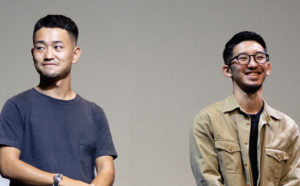
Roll director Daichi Murase and producer Daisuke Seki. ©Koichi Mori
Among the English-subbed Japanese short-to-feature-length films in the NARA-wave Student Film Competition, the standout — and eventual Audience Award winner — was the 91-minute Roll by Daichi Murase, a recent graduate of Kyoto Zokei University. An infinitely creative, often meandering, finally brilliant piece of experimental, expressionistic joie du cinema shot on video, 8mm and 16mm, it nominally tells the story of a dim-witted young man, Yoshihiro (a ripe-for-discovery Shingo Nakayama), who collects recyclable goods for his meager living, disassembles no-longer-useful items and sleeps on his floor amongst the pieces.
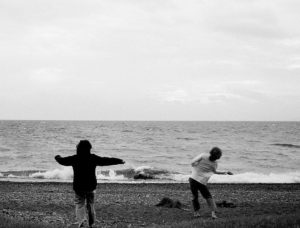
Roll Courtesy of NIFF
Clearing out a huge garage one day, he discovers a hidden room and a very strange young woman, Nazumi (Ami Sugihara), apparently locked inside it, wearing a Hazmat suit and watching a wall full of video monitors. As he lays plans to rescue her, another young man in Yoshihiro’s dorm (Iori Miyamoto) finds a Fujica 8mm camera, and becomes obsessed with making films about such subjects as “mushroom explosions” and “psychopath signals.”
Yoshihiro’s twin encounters, with Naz and with celluloid film, opens up an entirely new world for him, and it is so full of energy, of discovery and of reckless adventure, that the film's lack of cohesion becomes one of its many charms. The entire filmmaking team, including female scriptwriter Hibiki Terasawa, were fellow students for 3 years and “always make films together,” Murase told the audience during a Q&A session. “Our main motivation is to have fun while we’re doing it” — and the fun onscreen is infectious indeed.
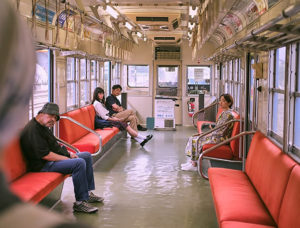 Food Lore: Life in a Box Courtesy of NIFF
Food Lore: Life in a Box Courtesy of NIFF
Actor-director Takumi Saitoh drew a sizeable crowd for the Japan premiere of Food Lore: Life in a Box, an episode he directed for the popular HBO Asia anthology series about food's power to create and shape relationships. Life in a Box focuses on a widower with a young daughter he may have to give up, a wrestler facing a life-or-death decision, and an author who’s lost her touch, all of whom are on the same train car heading to the countryside when there’s an unexpected delay. Luckily, the bento box lady arrives (the great Chieko Matsubara, looking at least 30 years younger than she has a right to), and they each experience a journey of memory and rediscovery, triggered by their taste buds.
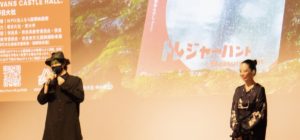
Takumi Saitoh, Kawase ©Koichi Mori
Appearing at the Q&A session afterward, Saitoh told Kawase that Matsubara’s character was inspired by a woman in Takasaki who’d been making and selling bento alone for 50 years, and that he’d worked with his scriptwriter to adapt true-life stories he’d heard from each of the actors in the film. He also admitted that the nostalgic single-car train had been inspired by Hayao Miyazaki’s Spirited Away.
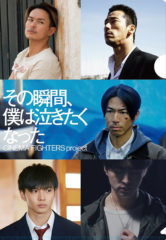
Cinema Fighters Courtesy of NIFF
The latest Cinema Fighters omnibus film package was also featured at NIFF, with work directed by Takashi Miike, lsao Yukisada, Daishi Matsunaga, Hiroki Horanai and Hiroki Inoue. The films, starring members of the LDH boy-band empire, are executive produced by LDH founder Exile Hiro and produced by Tetsuya Bessho, founder and director of Short Shorts Film Festival & Asia. The ongoing project takes poems by lyricist Masato Odake as their inspiration, yet filmmakers still manage to explore a diversity of styles and themes.
The two standouts from this collection are Takashi Miike’s surprisingly upbeat Beautiful, featuring Exile Akira as a suicidal salaryman who rescues a suicidal young woman when a destructive earthquake strikes, and how they deal with the survivor’s guilt; and Daishi Matsunaga’s Mexico-shot On the Way, about a young Japanese man’s life-altering run-in with would-be immigrants to the US in a dusty border town.
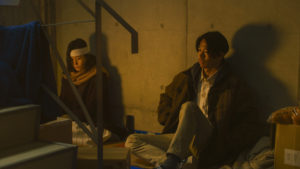
Beautiful Courtesy of NIFF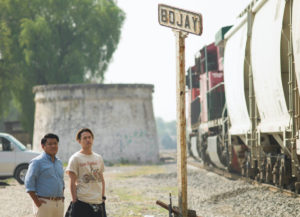
On the Way Courtesy of NIFF
Winding up the festival on its final day were screenings of the two films created by young teens in NIFF’s Youth Filmmaking Workshop. Held from August 16 to 23 under the tutelage of director Ryutaro Nakagawa (Silent Rain) and Kawase, the 11 participants worked together to plan, write, location hunt, film and edit their short pieces.
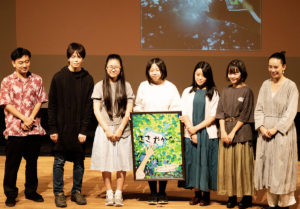
Just a Little Team ©Koichi Mori
Of the two, Just a Little was the more impressive. A fully formed narrative, it tells the tale of Yuka, an unhappy girl who happens upon a small bottle one day and follows the map enclosed. It leads her deep into the woods and a carefully hidden box. What she finds inside will unlock the small joys all around her and — after she holds her hand up to filter the sunlight, in a gesture of affectionate homage to Naomi Kawase — remind Yuka that life is what we make of it. — KS
Please be sure to check with the theater before going.
